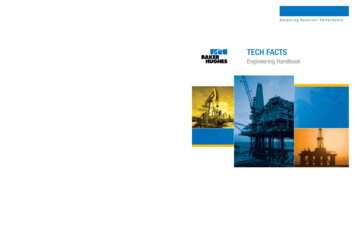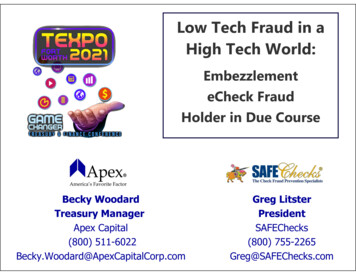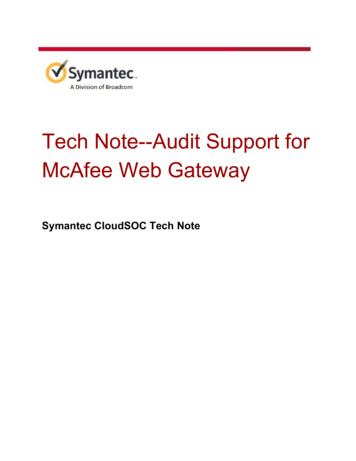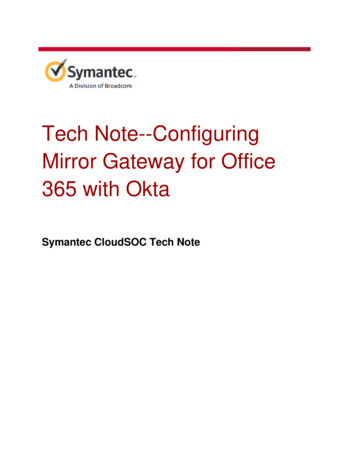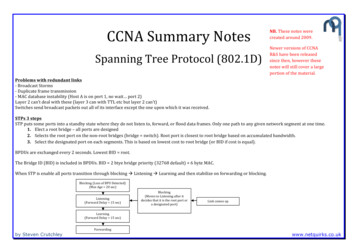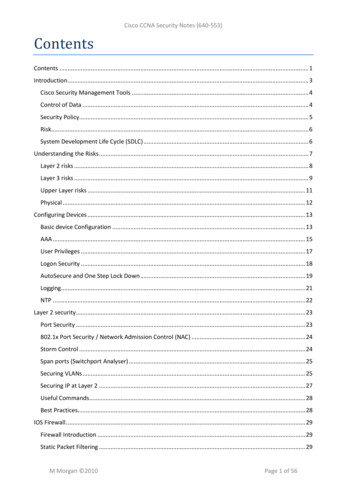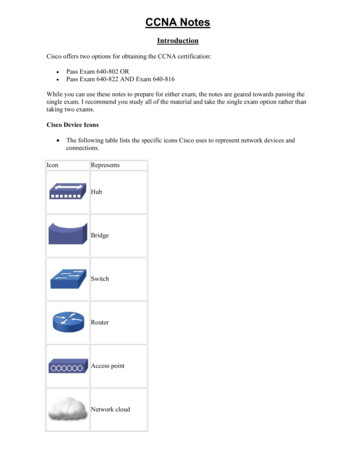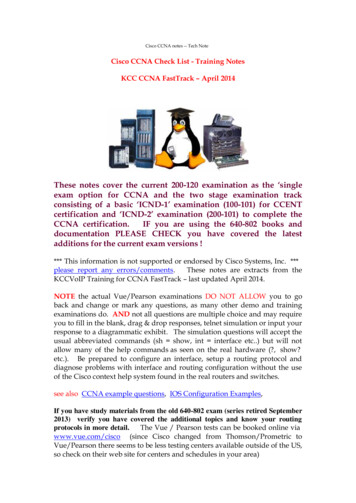
Transcription
Cisco CCNA notes -- Tech NoteCisco CCNA Check List - Training NotesKCC CCNA FastTrack – April 2014These notes cover the current 200-120 examination as the ‘singleexam option for CCNA and the two stage examination trackconsisting of a basic ‘ICND-1’ examination (100-101) for CCENTcertification and ‘ICND-2’ examination (200-101) to complete theCCNA certification.IF you are using the 640-802 books anddocumentation PLEASE CHECK you have covered the latestadditions for the current exam versions !*** This information is not supported or endorsed by Cisco Systems, Inc. ***please report any errors/comments.These notes are extracts from theKCCVoIP Training for CCNA FastTrack – last updated April 2014.NOTE the actual Vue/Pearson examinations DO NOT ALLOW you to goback and change or mark any questions, as many other demo and trainingexaminations do. AND not all questions are multiple choice and may requireyou to fill in the blank, drag & drop responses, telnet simulation or input yourresponse to a diagrammatic exhibit. The simulation questions will accept theusual abbreviated commands (sh show, int interface etc.) but will notallow many of the help commands as seen on the real hardware (?, show?etc.). Be prepared to configure an interface, setup a routing protocol anddiagnose problems with interface and routing configuration without the useof the Cisco context help system found in the real routers and switches.see also CCNA example questions, IOS Configuration Examples,If you have study materials from the old 640-802 exam (series retired September2013) verify you have covered the additional topics and know your routingprotocols in more detail.The Vue / Pearson tests can be booked online viawww.vue.com/cisco (since Cisco changed from Thomson/Prometric toVue/Pearson there seems to be less testing centers available outside of the US,so check on their web site for centers and schedules in your area)
Cisco IOS Study SummaryThe new examinations use a syllabus based upon extracts from IOS version15 commands and basic knowledge of the current ‘small enterprise’ networkdevices including the 29xx Catalyst series switches, 26xx /18xx/28xx‘standard IOS’ routers.The 2600 using IOS ver 12.4 are still excellenttraining routers and are available at very low cost, but any of the low endCisco routers can be used provided they will run a full IOS. Any IOS versionabove 12.3 will provide 90% of the commands you need (SDM functionalityand some of the manager commands will be missing). Any of the low endCatalyst switches can also be used to become familiar with the CCNArequirements for VLANs, VTP and trunking etc.The following documentis used as checklist within the KCC CCNA FastTrack Course; Switch and Router differences and connections via Console, Auxiliaryand Telnet options (rollover cables, cross cables, serial setup etc.) Router configuration, (memory use and functions RAM, FLASH, ROM,NVRAM) Router and Switch CLI (Command Line Interface) and exec modebasics for ;okey sequences for edit and recall etc. {lab #1}obasic boot system commandsofile system commands and tftp functions [NOTE. the CCNAexam ignores the use of FTP for IOS file transfers on largerrouters and states only tftp can be used for IOS file transfer]{lab #1}osystem messages commands for logging etc. {lab #1}ointerface configuration and monitoringoCDP functions {all labs}osetup menu commands etc. {lab #1}oIOS License functions {all labs}ohostname, banner, prompts etc. {lab #1}{lab #3}{all labs}
BASIC IOS FUNCTIONS REQUIRED BY CCNA;FUNCTION(PRACTICE !)COMMAND(may be abbreviated to firstfew non-ambiguous characters of each command)go into enable (privileged mode) enableexit from enable modedisablelogoff (leave the router)quit or exit or logoffprevious command from history up arrow or Ctrl-P next command from history down arrow or Ctrl-N move forward one character right arrow or Ctrl-F move back one character left arrow or Ctrl-B auto completion of command tab break (default) shift-Ctrl-6 x stop ping/trace shift-Ctrl-6 refresh console line Ctrl-L BASIC IOS ADMIN FUNCTIONS REQUIRED BY CCNA;(PRACTICE !)FUNCTIONCOMMAND(may be abbreviated to first few nonambiguous characters of each command)enter terminal configuration modeRouter # configure terminal(from the enable mode)exit terminal configuration modedrop back one level of contextwithin configcopy config from tftp server toRAMRouter (config)# Ctrl-Z or exit (eachlevel of context)Router (config-int)# exitRouter (config)#Router # copy tftp running-configsave/copy running-config (RAM) Router # write memory or copy runningto NVRAMconfig startup-configcopy file from tftp server to flashmemoryRouter # copy tftp flashcopy file from flash to tftp serverRouter # copy flash tftpdelete start-up (NVRAM)configurationRouter # write erase or erase startupconfigview IOS version informationRouter show version
view current configuration (RAM)Router # show running-config or writeterminalview saved (startup) configurationRouter # show config or show startupconfigview basic files system (flash)Router # show flashview router utilizationRouter # show processesdisable CDP for entire routerRouter (config) # no cdp rundisable CDP on an interfaceRouter (config-int) # no cdp enable(or dir)show interfaces and ip addressing Router show ip interface briefshow routing tableRouter show ip routeshow routing protocols for ipRouter # show ip protocolshow ip arp tableRouter # show ip arpsee also IOS Configuration Examples, configuration register settings forpassword recoveryOSI Reference Model Study SummaryoOSI Reference model & examples (table below)oConnectionless and connection oriented protocolsoData Link protocol functions (Arbitration, Addressing, Error Detection& Types)oLayer 3 protocol address structures (IP, OSI), network/host field sizesoFrames, Packets and Segments (layer 2,3 & 4)oFlow control methods (buffering, congestion avoidance andwindowing) MAC address functions (NIC, LAA, Unicast, Multicast, Broadcast)
NETWORK LAYER UTILITIES;REMEMBERARP Address Resolution Protocol will resolve a mac address from a given ipaddress. A device may send an ARP broadcast to ask every station on it’snetwork for the mac address of a given IP address. REMEMBER HOW theip address and mask dictate if the device should send traffic to it’s localnetwork or to it’s gateway.DNS Domain Name System will resolve domain names to IP addresses. So adevice looking for cisco.com will request a domain lookup from it’s DNSserver to be able to send traffic to the IP address of cisco.com ( and then usingARP to resolve the IP address of cisco.com to a mac address in order to sendit’s traffic)DHCP Dynamic Host Configuration Protocol can be used to supply IPaddresses to any device either via static configuration (mapped to macaddress) or via a pool of addresses. DHCP can also provide much moreinformation to the end device such as multiple DNS server addresses andTFTP server addresses etc.
OSI MODEL AND EXAMPLES;OSI Layer NameDescriptionExampleApplicationlayer 7Application / userinterface(including userauthentication etc)Telnet, HTTP, FTP, SMTP,SNMP, VoIP, POP3, FTPPresentationlayer 6Data translation/presentation /encryptionJPEG, EBCDIC, ASCII,GIF, MPEG, MIDI,Encryption.Sessionlayer 5Session control,allocation/trackingop systems, SQL, NetBIOS,DECnetlayer 4Multiplexing /control,Data delivery usingflow control and errorrecovery &segmentation etcTCP, UDP, SPXlayer 3logical addressing andpath determination(routing)IP, IPX, AppleTalk, X.25Data Linklayer 2frame construction, macaddressing, error802.2/802.3, VTP, HDLC,detection using frameATM, PPP, Frame Relay,check sequenceEthernet, CDP.(switching)Physicallayer 1Electrical connections &Cables specifications; RJ45,signals physicalV.35, EIA232, EthernetmediaTransportNetworkTHERE ARE ALWAYS SEVERAL QUESTIONS ON THE OSI MODEL !!
TCP/IP Layer NameDescriptionExampleApplicationApplication / userinterface / PresentationTelnet, HTTP, FTP, SMTP,and session control)SNMP, VoIP, POP3, FTPmaps to Layers 5, 6 & 7 ofOSITransportMultiplexing /control,Data delivery usingflow control and errorrecovery etc . maps toLayer 4 of OSITCP, UDPInternetlogical addressing andpath determinationmaps to layer 3 of OSIIPNetwork AccessMaps to Layer 1 & 2 ofOSI model macprotocols & physicalmedia etc802.2/802.3, PPP, FrameRelay, Ethernet, CDP.(Physical layer sometimes said to be the separate layer-1 of the TCP/IPstack)REMEMBER;CONNECTIONLESSTFTP, UDP, 802.3, 802.5.(most layer 3)CONNECTION ORIENTED (i.e. requires end to end communications)LLC2, 802.2, TCP/IP, SPX, X.25, Frame Relay, ATM, PPP, xDSL.‘SAME-LAYER INTERACTION ON DIFFERENT COMPUTERS’ twocomputers using the same protocol to communicate‘ADJACENT-LAYER INTERACTION ON SAME COMPUTER’ a singlecomputer making use of the protocol stack where one layer provides a serviceto an adjacent layer within the OSI model
Bridges/Switches, LAN Design Study Summary Protocol Type Fields and header formats – basic knowledge Ethernet Standards (mac specifications, cable lengths & types)KNOW the definitions of ; collision domain, broadcast domain andnetwork segment ! Spanning Tree basic functions (now including RSTP 802.1w andPVSTP) – no need to know the timing and protocol details, but essential toknow the port naming, election procedure, bridge ID and basicspanning tree functionality. VLANs overview inter-vlan routing, collision domain / broadcastdomain and segments Trunking/Tagging Protocols & VTP basics (VTP modes, taggingspecifications ISL/802.1q) switching methods (see table below) Switch port security – know the methods and configuration commandsSwitching Methods;Store and Forward Switch port fully receives all bits in the frame beforeforwarding the frame. The switch checks the FCS in the Ethernet trailerbefore forwarding the frame.Cut Through Switch performs an address lookup as soon as the destinationfield header has been received. The first bits in the frame can be sent outbefore the final bits of the incoming frame are received, therefore the FCS cannot be checked.Fragment Free Switch acts in the same way as cut through switching, butwaits for 64 bytes to be received before forwarding to ensure collision errorsdid not occur. The FCS is not checked.NOTE fortunately, the CCNA no longer requires knowledge of the 'odd'1900 switches etc. ;Catalyst 29xx and other low-end catalyst switches now tend to use a more'standard' Cisco operating system (we no longer need the strange 1900). Allhave a separate VLAN-database configuration mode in addition to the 'config'mode and use an IOS format. {LAB #9}Larger switches such as Catalyst
6500 etc. use can CatOS or a Hybrid combination of IOS/CatOS on theswitching processors and some have separate IOS on the layer-3 routingprocessors - fortunately, the CatOS is no longer required for CCNA .REMEMBER: VTP MODES on all Cisco Catalyst switches (flooded every5mins & when ever there has been a change);FunctionServerClientTransparentsource VTP messagesyesyesnolisten to VTP messagesyesyesnocreate/edit/delete VTPmessagesyesnolocalsave VTP messagesyesnolocalTRUNK/TAGGING DETAILS;oCisco's ISL encapsulation (adds 26 bytes overhead) tagging for VLANidentification for Fast Ethernet or Gigabit Ethernet links onlyo802.1Q is the IEEE standard (subset of Cisco's ISL) for VLAN taggingadds a 4 byte shimo802.10 tagging on FDDIoLANE tagging on ATMoDISL is Cisco's first generation trunk establishment protocoloDTP is Cisco's second generation of trunk establishment protocoloVTP is Cisco's method for distribution of VLAN configurationinformationoVTP pruning increases available bandwidth by restricting floodedtraffic to contain only the required/configured VLANs for that trunkand not sending all available VLAN informationsee also VLAN Overview
Network Protocols Study Summary TCP/IP (RFC 793, UDP, port numbers and type numbers (RFC 1700),DNS, ARP, ICMP)IP Addressing and classes (subnet masking before VLSM), defaultroutes ESSENTIAL YOU CAN CALCULATE VLSM ADDRESSINGFAST !!!!!Classful addressing and VLSM & CIDR (basic knowledge)Encapsulation in IPIP and MAC addressing flowDNS, DHCP and general WEB traffic flowNAT addressing terms (very basic knowledge)FTP TFTP (basic knowledge of commands and functions)IOS commands (CCNA sub-set of commands – see below)SSH (know the steps to configure SSH on a switch and the principal ofRSA public/private key exchange)Basic Network Management functions (SNMP version1 and version2)KNOW CDP and what it can show, how it can help fault findingcommon IP configuration commands; (practice these commands !)show ip protocolview routing protocols in use for ipshow controller {serial ethernet .}view controller for interface (checkcable type etc)show debugview current debug settingshow versionview config register, device spec andcurrent IOS etcip address ip-address mask {secondary}configure an IP address on to aninterfacedebug ip packetdiagnose & view all IP packetsip domain-lookupconfigure use of dnsip netmask-format {bitcount decimal format configuration for interfacehexadecimal}address viewshow ip arp {mac}view IP arp tableip host name {tcp-port-number} address1address2.configuration of host tableip route prefix mask {next hop outputinterface}configure static routeip name-server server address1 {serveraddress2.}configure name server(s) for DNSno ip domain-lookupswitch OFF DNS lookups from thisdevice for management (default is ON)
show clockview date and time settingclock set {HH:MM:SS DD MMM YYYY} set date and time for this deviceshow ip interface {brief}view IP interface detailsshow ip route {subnet} {protocol}view IP routing tablesee also IOS Configuration Examples, well known tcp port numbers, NAT &PATWiFI – CCNA NEED TO KNOW;WiFi WLAN ModeDescriptionCisco exam ‘phrase’Ad hoc (peer to peer)Two devicescommunicate directlywithout the use of anAPIndependent Basic ServiceSet (IBSS)Infrastructure modeSingle
Cisco CCNA notes -- Tech Note Cisco CCNA Check List - Training Notes KCC CCNA FastTrack . Bridges/Switches, LAN Design Study Summary Protocol Type Fields File Size: 365KBPage Count: 16

